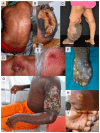Integrated Management of Skin NTDs-Lessons Learned from Existing Practice and Field Research
- PMID: 30441754
- PMCID: PMC6306929
- DOI: 10.3390/tropicalmed3040120
Integrated Management of Skin NTDs-Lessons Learned from Existing Practice and Field Research
Abstract
Integration of neglected tropical diseases (NTDs) into the public health agenda has been a priority in global health for the last decade. Because a number of these diseases share not only the geographical distribution, but also a common feature which is skin involvement, bringing together a sub-group of 'skin NTDs' is one way forward to promote further integration among NTDs. With these diseases, which include leprosy, Buruli ulcer, yaws, mycetoma, lymphatic filariasis, and leishmaniasis, patients may be left with life-long deformities and disabilities when diagnosis and treatment are delayed. Stigma is another serious consequence of skin NTDs as it places a large barrier on the economic activities and social life of a patient. As a result, this creates a vicious cycle and obstructs a key goal of society, the elimination of poverty. Enhancement in surveillance systems as well as the further development of diagnostic methods, improvement in treatment and management, and identification of preventative measures for skin NTDs are therefore urgently needed. This article summarizes the existing practices and field research on skin NTDs and identifies potential synergies that could be achieved by adopting this integrated approach.
Keywords: case management; integration; mass drug administration; neglected tropical diseases; skin NTDs; skin infections; surveillance; training; tropical skin diseases.
Conflict of interest statement
Nothing to declare.
Figures



Similar articles
-
Deep learning for AI-based diagnosis of skin-related neglected tropical diseases: a pilot study.medRxiv [Preprint]. 2023 Mar 15:2023.03.14.23287243. doi: 10.1101/2023.03.14.23287243. medRxiv. 2023. Update in: PLoS Negl Trop Dis. 2023 Aug 14;17(8):e0011230. doi: 10.1371/journal.pntd.0011230. PMID: 36993502 Free PMC article. Updated. Preprint.
-
Assessing the cost-effectiveness of integrated case management of Neglected Tropical Diseases in Liberia.BMC Health Serv Res. 2023 Jun 29;23(1):705. doi: 10.1186/s12913-023-09685-0. BMC Health Serv Res. 2023. PMID: 37386431 Free PMC article.
-
"Buruli ulcer and leprosy, they are intertwined": Patient experiences of integrated case management of skin neglected tropical diseases in Liberia.PLoS Negl Trop Dis. 2020 Feb 5;14(2):e0008030. doi: 10.1371/journal.pntd.0008030. eCollection 2020 Feb. PLoS Negl Trop Dis. 2020. PMID: 32023242 Free PMC article.
-
Finishing the task of eliminating neglected tropical diseases (NTDs) in WHO South-East Asia Region: promises kept, challenges, and the way forward.Lancet Reg Health Southeast Asia. 2023 Oct 29;18:100302. doi: 10.1016/j.lansea.2023.100302. eCollection 2023 Nov. Lancet Reg Health Southeast Asia. 2023. PMID: 38028173 Free PMC article. Review.
-
Neglected tropical diseases: an effective global response to local poverty-related disease priorities.Infect Dis Poverty. 2020 Jan 28;9(1):10. doi: 10.1186/s40249-020-0630-9. Infect Dis Poverty. 2020. PMID: 31987053 Free PMC article. Review.
Cited by
-
Diagnosing skin neglected tropical diseases with the aid of digital health tools: A scoping review.PLOS Digit Health. 2024 Oct 7;3(10):e0000629. doi: 10.1371/journal.pdig.0000629. eCollection 2024 Oct. PLOS Digit Health. 2024. PMID: 39374195 Free PMC article.
-
Training and Active Case Detection to Prevent Leprosy: Effect on Knowledge, Attitude and Skills of Health Workers on Early Diagnosis of Leprosy in a Leprosy Hotspot District in Ethiopia.Trop Med Infect Dis. 2024 Feb 23;9(3):51. doi: 10.3390/tropicalmed9030051. Trop Med Infect Dis. 2024. PMID: 38535876 Free PMC article.
-
Community based integrated wound care: Results of a pilot formative research conducted in Benin and Côte d'Ivoire, West Africa.PLOS Glob Public Health. 2024 Feb 9;4(2):e0002889. doi: 10.1371/journal.pgph.0002889. eCollection 2024. PLOS Glob Public Health. 2024. PMID: 38335227 Free PMC article.
-
The NLR SkinApp: Testing a Supporting mHealth Tool for Frontline Health Workers Performing Skin Screening in Ethiopia and Tanzania.Trop Med Infect Dis. 2024 Jan 10;9(1):18. doi: 10.3390/tropicalmed9010018. Trop Med Infect Dis. 2024. PMID: 38251215 Free PMC article.
-
The Early Detection and Case Management of Skin Diseases With an mHealth App (eSkinHealth): Protocol for a Mixed Methods Pilot Study in Côte d'Ivoire.JMIR Res Protoc. 2022 Sep 21;11(9):e39867. doi: 10.2196/39867. JMIR Res Protoc. 2022. PMID: 35922062 Free PMC article.
References
-
- Hotez P. Forgotten People, Forgotten Diseases: The Neglected Tropical Diseaes and Their Impact on Global Health and Development. 2nd ed. ASM Press; Washington, DC, USA: 2013.
-
- Department of Control of Neglected Tropical Diseases, WHO . Neglected Tropical Diseases. WHO; Geneva, Switzerland: 2018. [(accessed on 5 August 2018)]. Available online: http://www.who.int/neglected_diseases/diseases/en/
Publication types
LinkOut - more resources
Full Text Sources
Research Materials

